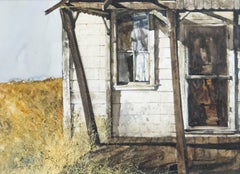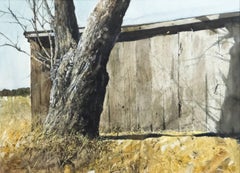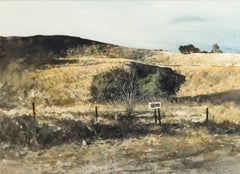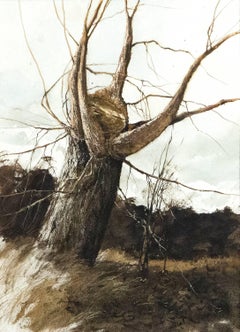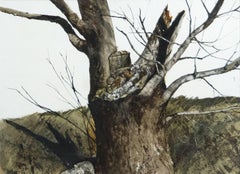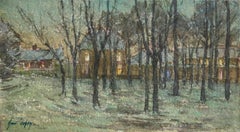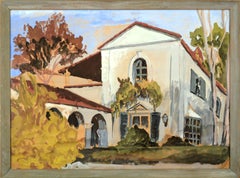Gregory Sumida Art
to
7
7
7
7
Dealer: Heather James Fine Art
Vacated
By Gregory Sumida
Located in Palm Desert, CA
A watercolor by Gregory Sumida. "Vacated" is a watercolor on watercolor board executed in blues, yellows, greens, browns and whites and depicting a dilapidated and abandoned home set...
Category
1970s American Realist Gregory Sumida Art
Materials
Board, Watercolor
Tree Trunk and Barn
By Gregory Sumida
Located in Palm Desert, CA
A watercolor by Gregory Sumida. "Tree Trunk and Barn" is a watercolor on pressed board executed in earthy browns, yellows, whites and blues and depicting a bare branched, tree trunk ...
Category
1970s American Realist Gregory Sumida Art
Materials
Board, Watercolor
Fence Support
By Gregory Sumida
Located in Palm Desert, CA
A watercolor by Gregory Sumida. "Fence Support" is a watercolor executed in greens, blues yellows and browns and depicts a pair of barren trees against a barbed wire fence...
Category
1970s American Realist Gregory Sumida Art
Materials
Watercolor
Distant Shade, Knights Ferry, CA
By Gregory Sumida
Located in Palm Desert, CA
A watercolor by Gregory Sumida. "Distant Shade, Knights Ferry, CA" is a watercolor, executed in earthy yellows, browns, blues and greens and depicting a California landscape of rolli...
Category
1970s American Realist Gregory Sumida Art
Materials
Watercolor
Approaching Storm, New Branches
By Gregory Sumida
Located in Palm Desert, CA
A watercolor by Gregory Sumida. "Approaching Storm, New Branches" is a watercolor on watercolor board, executed in dark browns, greens and blues and depicting a tree trunk with bare ...
Category
1970s American Realist Gregory Sumida Art
Materials
Board, Watercolor
Supported
By Gregory Sumida
Located in Palm Desert, CA
A watercolor by Gregory Sumida. "Supported" is a watercolor on watercolor board executed in earthy browns, blues, greens, yellows and white and depicts a cut tree trunk with dry, bar...
Category
1970s Gregory Sumida Art
Materials
Board, Watercolor
Branches
By Gregory Sumida
Located in Palm Desert, CA
A watercolor by Gregory Sumida. "Branches" is a watercolor on paper executed in browns, greens, yellows and blue and depicting a tree trunk with bare branches set against a landscape...
Category
1970s American Realist Gregory Sumida Art
Materials
Watercolor, Paper
Related Items
Snowy Night - Douai - 19th Century Watercolor, French Village in Snow by H Duhem
By Henri Duhem
Located in Marlow, Buckinghamshire
Watercolour on card circa 1900. Signed lower left. This painting is not currently framed but a suitable frame can be sourced if required.
Descendant of an old Flemish family, Henri ...
Category
Early 20th Century Impressionist Gregory Sumida Art
Materials
Watercolor, Cardboard
Mid Century California Mission Landscape
Located in Soquel, CA
Beautiful mid century landscape of a historic California mission, highlighting its iconic architectural details such as a columned arches, white was...
Category
Mid-20th Century American Impressionist Gregory Sumida Art
Materials
Gouache, Cardboard, Paper
Whimsical Fishing Illustration Cartoon 1938 Mt Tremblant Ski Lodge William Steig
By William Steig (b.1907)
Located in Surfside, FL
Lighthearted Illustration of Outdoor Pursuits This one of a fisherman signed "W. Steig"
Provenance: from Mrs. Joseph B. Ryan, Commissioned by Joe Ryan for the bar at his ski resort, Mount Tremblant Lodge, in 1938.
Mont Tremblant, P.Q., Canada
Watercolor and ink on illustration board, sights sizes 8 1/2 x 16 1/2 in., framed.
In 1938 Joe Ryan, described as a millionaire from Philadelphia, bushwhacked his way to the summit of Mont Tremblant and was inspired to create a world class ski resort at the site. In 1939 he opened the Mont Tremblant Lodge, which remains part of the Pedestrian Village today. This original illustration is on Whatman Illustration board. the board measures 14 X 22 inches. label from McClees Galleries, Philadelphia, on the frame backing paper.
William Steig, 1907 – 2003 was an American cartoonist, sculptor, and, in his later life, an illustrator and writer of children's books. Best known for the picture books Sylvester and the Magic Pebble, Abel's Island, and Doctor De Soto, he was also the creator of Shrek!, which inspired the film series of the same name. He was the U.S. nominee for both of the biennial, international Hans Christian Andersen Awards, as a children's book illustrator in 1982 and a writer in 1988.
Steig was born in Brooklyn, New York in 1907, and grew up in the Bronx. His parents were Polish-Jewish immigrants from Austria, both socialists. His father, Joseph Steig, was a house painter, and his mother, Laura Ebel Steig, was a seamstress who encouraged his artistic leanings. As a child, he dabbled in painting and was an avid reader of literature. Among other works, he was said to have been especially fascinated by Pinocchio.He graduated from Townsend Harris High School at 15 but never completed college, though he attended three, spending two years at City College of New York, three years at the National Academy of Design and a mere five days at the Yale School of Fine Arts before dropping out of each.
Hailed as the "King of Cartoons" Steig began drawing illustrations and cartoons for The New Yorker in 1930, producing more than 2,600 drawings and 117 covers for the magazine. Steig, later, when he was 61, began writing children's books. In 1968, he wrote his first children's book. He excelled here as well, and his third book, Sylvester and the Magic Pebble (1969), won the Caldecott Medal. He went on to write more than 30 children's books, including the Doctor DeSoto series, and he continued to write into his nineties. Among his other well-known works, the picture book Shrek! (1990) formed the basis for the DreamWorks Animation film Shrek (2001). After the release of Shrek 2 in 2004, Steig became the first sole-creator of an animated movie franchise that went on to generate over $1 billion from theatrical and ancillary markets after only one sequel. Along with Maurice Sendak, Saul Steinberg, Ludwig Bemelmans and Laurent de Brunhofff his is one of those rare cartoonist whose works form part of our collective cultural heritage.
In 1984, Steig's film adaptation of Doctor DeSoto directed by Michael Sporn was nominated for the Academy Award for Best Animated Short Film. As one of the most admired cartoonists of all time, Steig spent seven decades drawing for the New Yorker magazine. He touched generations of readers with his tongue–in–cheek pen–and–ink drawings, which often expressed states of mind like shame, embarrassment or anger. Later in life, Steig turned to children's books, working as both a writer and illustrator.
Steig's children's books were also wildly popular because of the crazy, complicated language he used—words like lunatic, palsied, sequestration, and cleave. Kids love the sound of those words even if they do not quite understand the meaning. Steig's descriptions were also clever. He once described a beached whale as "breaded with sand."
Throughout the course of his career, Steig compiled his cartoons and drawings into books. Some of them were published first in the New Yorker. Others were deemed too dark to be printed there. Most of these collections centered on the cold, dark psychoanalytical truth about relationships. They featured husbands and wives fighting and parents snapping at their kids. His first adult book, Man About Town, was published in 1932, followed by About People, published in 1939, which focused on social outsiders. Sick of Each Other, published in 2000, included a drawing depicting a wife holding her husband at gunpoint, saying, "Say you adore me."
According to the Los Angeles Times, fellow New Yorker artist...
Category
1930s American Modern Gregory Sumida Art
Materials
India Ink, Watercolor, Illustration Board
"The Red Silo" Winold Reiss, Rural Regionalist Landscape, Sunny Day on Farm
By Winold Reiss
Located in New York, NY
Winold Reiss
The Red Silo
Signed lower left
Watercolor on paper
20 x 29 inches
Winold Reiss (1886-1953) was an artist and designer who emigrated to the United States from Germany in 1913. Probably best known as a portraitist, Reiss was a pioneer of modernism and well known for his brilliant work in graphic and interior design. A compassionate man who greatly respected all people as human beings, he believed that his art could help break down racial prejudices. Like his father Fritz Reiss (1857-1915), who was also an artist and who was his son's first teacher, Winold Reiss was artistically moved by diverse cultures. The elder Reiss focused on folk life in Germany while Winold drew substantial inspiration from a range of cultures, particularly Native American, Mexican, and African-American.
As did many young aspiring artists, Winold Reiss studied with the esteemed painter and teacher Franz von Stuck at the Royal Academy of Fine Arts in Munich, which was at that time a center of the decorative and fine-arts movement. It is not known whether Reiss met E. Martin Hennings...
Category
Mid-20th Century American Realist Gregory Sumida Art
Materials
Paper, Watercolor
“Waterfall with Birches”
Located in Southampton, NY
Original watercolor of a waterfall with birch trees on illustration board by the well known American artist, William Paskell. Signed lower left. Condi...
Category
1920s Post-Impressionist Gregory Sumida Art
Materials
Watercolor, Illustration Board
Hotel Futura Illustration
By Joseph Binder
Located in Miami, FL
Men Who Plan Beyond Tomorrow” Advertising campaign for
The world’s incredible technological inventions that we take for granted today …..
Provenance: Edgar Bronfman Sr. former C...
Category
1940s Futurist Gregory Sumida Art
Materials
Illustration Board, Gouache
Irises Ink, Watercolor, Oil on Yupo paper 26” x 40” Framed 31 ¼” x 45 ¼”
Located in Houston, TX
Yellow Poppies by Texas artist Julie England is an Ink and Watercolor, Oil on Yupo paper. The size of Yellow Poppies is Image 26” x 40” Framed 31 ¼” x 45 ¼” Yellow Poppies by J...
Category
2010s American Realist Gregory Sumida Art
Materials
Oil, Watercolor, Mixed Media
Whimsical Illustration Hiking Cartoon, 1938 Mt Tremblant Ski Lodge William Steig
By William Steig (b.1907)
Located in Surfside, FL
Lighthearted Illustration of Outdoor Pursuits This one being cross country hiking signed "W. Steig"
Provenance: from Mrs. Joseph B. Ryan, Commissioned by Joe Ryan for the bar at his ski resort, Mount Tremblant Lodge, in 1938.
Mont Tremblant, P.Q., Canada
Watercolor and ink on illustration board, sights sizes 8 1/2 x 16 1/2 in., framed.
In 1938 Joe Ryan, described as a millionaire from Philadelphia, bushwhacked his way to the summit of Mont Tremblant and was inspired to create a world class ski resort at the site. In 1939 he opened the Mont Tremblant Lodge, which remains part of the Pedestrian Village today. This original illustration is on Whatman Illustration board. the board measures 14 X 22 inches. label from McClees Galleries, Philadelphia, on the frame backing paper.
William Steig, 1907 – 2003 was an American cartoonist, sculptor, and, in his later life, an illustrator and writer of children's books. Best known for the picture books Sylvester and the Magic Pebble, Abel's Island, and Doctor De Soto, he was also the creator of Shrek!, which inspired the film series of the same name. He was the U.S. nominee for both of the biennial, international Hans Christian Andersen Awards, as a children's book illustrator in 1982 and a writer in 1988.
Steig was born in Brooklyn, New York in 1907, and grew up in the Bronx. His parents were Polish-Jewish immigrants from Austria, both socialists. His father, Joseph Steig, was a house painter, and his mother, Laura Ebel Steig, was a seamstress who encouraged his artistic leanings. As a child, he dabbled in painting and was an avid reader of literature. Among other works, he was said to have been especially fascinated by Pinocchio.He graduated from Townsend Harris High School at 15 but never completed college, though he attended three, spending two years at City College of New York, three years at the National Academy of Design and a mere five days at the Yale School of Fine Arts before dropping out of each.
Hailed as the "King of Cartoons" Steig began drawing illustrations and cartoons for The New Yorker in 1930, producing more than 2,600 drawings and 117 covers for the magazine. Steig, later, when he was 61, began writing children's books. In 1968, he wrote his first children's book. He excelled here as well, and his third book, Sylvester and the Magic Pebble (1969), won the Caldecott Medal. He went on to write more than 30 children's books, including the Doctor DeSoto series, and he continued to write into his nineties. Among his other well-known works, the picture book Shrek! (1990) formed the basis for the DreamWorks Animation film Shrek (2001). After the release of Shrek 2 in 2004, Steig became the first sole-creator of an animated movie franchise that went on to generate over $1 billion from theatrical and ancillary markets after only one sequel. Along with Maurice Sendak, Saul Steinberg, Ludwig Bemelmans and Laurent de Brunhofff his is one of those rare cartoonist whose works form part of our collective cultural heritage.
In 1984, Steig's film adaptation of Doctor DeSoto directed by Michael Sporn was nominated for the Academy Award for Best Animated Short Film. As one of the most admired cartoonists of all time, Steig spent seven decades drawing for the New Yorker magazine. He touched generations of readers with his tongue–in–cheek pen–and–ink drawings, which often expressed states of mind like shame, embarrassment or anger. Later in life, Steig turned to children's books, working as both a writer and illustrator.
Steig's children's books were also wildly popular because of the crazy, complicated language he used—words like lunatic, palsied, sequestration, and cleave. Kids love the sound of those words even if they do not quite understand the meaning. Steig's descriptions were also clever. He once described a beached whale as "breaded with sand."
Throughout the course of his career, Steig compiled his cartoons and drawings into books. Some of them were published first in the New Yorker. Others were deemed too dark to be printed there. Most of these collections centered on the cold, dark psychoanalytical truth about relationships. They featured husbands and wives fighting and parents snapping at their kids. His first adult book, Man About Town, was published in 1932, followed by About People, published in 1939, which focused on social outsiders. Sick of Each Other, published in 2000, included a drawing depicting a wife holding her husband at gunpoint, saying, "Say you adore me."
According to the Los Angeles Times, fellow New Yorker artist Edward Sorel...
Category
1930s Naturalistic Gregory Sumida Art
Materials
Archival Ink, Watercolor, Illustration Board
Mid Century Horse in Winter Landscape
By William Ernest Smyth
Located in Soquel, CA
Charming mid century watercolor painting of a horse in winter with a barn in the background by Ernest Smythe (American/England 1881-1950). Signed "ERNEST SMYTHE" in lower left corner. Presented in a tan mat with a wood frame and glass. Image size: 25"H x 19.75"W
As William Ernest Smyth, he was born at 13 Commercial Road, Ipswich on 9 April 1874 but was not baptised at St Michael's, Ipswich until 23 October 1885, when his birth date is given as 17 February 1874, youngest son of artist Thomas Smythe...
Category
Mid-20th Century Realist Gregory Sumida Art
Materials
Watercolor, Illustration Board
Thomaston Maine, Original Rooftop View Townscape in Watercolor
Located in Doylestown, PA
"Thomaston, Maine" is a 15 x 13.5 inches, watercolor townscape, signed in the lower left, and framed behind glass.
Ranulph Bye was born in 1916 in Princet...
Category
20th Century American Realist Gregory Sumida Art
Materials
Watercolor, Archival Paper
Whimsical Illustration "Snow" Cartoon, 1938 Mt Tremblant Ski Lodge William Steig
By William Steig (b.1907)
Located in Surfside, FL
Lighthearted Illustration of Outdoor Pursuits This one being cross country Snow Shoes signed "W. Steig"
Provenance: from Mrs. Joseph B. Ryan, Commissioned by ...
Category
1930s American Modern Gregory Sumida Art
Materials
India Ink, Watercolor, Illustration Board
"A Passing Storm" Watercolour By D Cox 1783 1859
By David Cox Snr. OWS
Located in Brecon, Powys
Very good quality work by this renouned English artist.
Watercolour on paper on board.
David Cox 1783-1859
David Cox was an English landscape painter, one of the most important memb...
Category
Early 19th Century Victorian Gregory Sumida Art
Materials
Paper, Watercolor, Board
Gregory Sumida art for sale on 1stDibs.
Find a wide variety of authentic Gregory Sumida art available for sale on 1stDibs. You can also browse by medium to find art by Gregory Sumida in paint, watercolor, board and more. Not every interior allows for large Gregory Sumida art, so small editions measuring 22 inches across are available. Customers who are interested in this artist might also find the work of Jon Carsman, Louis Kronberg, and Thomas Strickland. Gregory Sumida art prices can differ depending upon medium, time period and other attributes. On 1stDibs, the price for these items starts at $21,000 and tops out at $25,000, while the average work can sell for $25,000.
